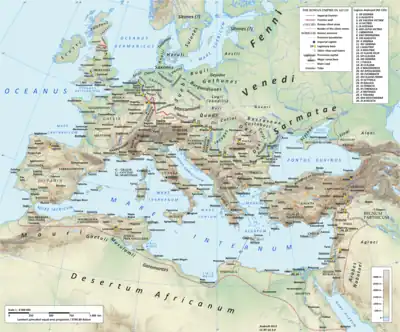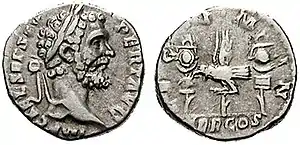

Legio I Minervia (lit. First Legion "Minervan", i.e., "devoted to the goddess Minerva") was a legion of the Imperial Roman army founded in AD 82 by emperor Domitian (r. 81–96), for his campaign against the Germanic tribe of the Chatti. Its cognomen refers to the goddess Minerva, the legion's protector. There are still records of the I Minervia in the Rhine border region in the middle of the 4th century. The legion's emblem is an image of goddess Minerva.
Legio I Minervia first, and main, camp was in the city of Bonna (modern Bonn), in the province of Germania Inferior. In 89, they suppressed a revolt of the governor of Germania Superior. Due to this, Domitian gave them the cognomen Pia Fidelis Domitiana (loyal and faithful to Domitian) to acknowledge their support.
History
Between 101 and 106, the legion fought the Dacian Wars of emperor Trajan, commanded by Hadrian, the future emperor. The emblem with Minerva figure appears on the column of Trajan in Rome, along with symbols of other legions. After this war, I Minervia returned to its home city of Bonna. Together with XXX Ulpia Victrix, stationed close by in Castra Vetera II (modern Xanten), they worked in numerous military and building activities, even extracting stone from quarries.
Although it belonged to the Germanic army and Bonn was its camp, vexillationes (subunits) of the legion were allocated in different parts of the Empire:
- 162–166 war against the Parthian Empire, commanded by emperor Lucius Verus
- 166–175 and 178–180 war against the Marcomanni, commanded by emperor Marcus Aurelius
- 173 campaign against the Chauci of Gallia Belgica, commanded by governor Didius Julianus
- 198–211 garrison of the city of Lugdunum, capital of Gallia
During the civil wars of the late 2nd and 3rd century, I Minervia supported the following emperors (each of them gave them the indicated titles, dropped out after their fall):
- Septimius Severus
- Elagabalus (Antoniniana)
- Alexander Severus (Severiana Alexandriana)
- The Gallic Empire, that existed between 260 and 274
Around 353, Bonna was destroyed by the Franks. Although Legio I Minervia disappears from recorded history, there is no account of its end, whether destroyed in battle or simply disbanded.
Attested members
| Name | Rank | Time frame | Province | Source |
|---|---|---|---|---|
| Quintus Sosius Senecio[1] | legatus legionis | c. 93 | CIL VI, 1444 | |
| Publius Aelius Hadrianus | legatus legionis | c. 103-106 | Germania Inferior | Historia Augusta, "Hadrian", 3 |
| Marcus Pontius Laelianus[2] | legatus legionis | c. 138-c. 141 | Germania Inferior | CIL VI, 1497 |
| Lucius Pullaienus Gargilius Antiquus[2] | legatus legionis | c. 155-c. 158 | Germania Inferior | CIL III, 7394 |
| Marcus Claudius Fronto[2] | legatus legionis | 162-c. 165 | Germania Inferior | CIL VI, 1377 |
| Gaius Scribonius Genialis[2] | legatus legionis | 166/169 or 177/180 | Germania Inferior | CIL XIII, 12036 |
| Lucius Calpurnius Proculus[3] | legatus legionis | ?180/185 | Germania Inferior | CIL XIII, 8009 |
| Claudius Stratonicus[3] | legatus legionis | ?184-?186 | Germania Inferior | IGRR IV.570 |
| Claudius Apollinaris[3] | legatus legionis | ?187-?189 | Germania Inferior | CIL XIII, 7946 |
| [...] Plotinus[3] | legatus legionis | between 190 and 192 | Germania Inferior | CIL XIII, 8598 |
| Quintus Venidius Rufus Marius Maximus Lucius Calvinianus[3] | legatus legionis | c. 193 | Germania Inferior | CIL XIII, 7994 |
| Titus Flavius Secundus Phillipianus[3] | legatus legionis | c. 194-195/196? | Germania Inferior | CIL XIII, 1673 |
| Gaius Julius Septimius Castinus[4] | legatus legionis | c. 205 or c. 208 | CIL XIII, 7945 = ILS 2549 | |
| Gaius Fabius Agrippinus[4] | legatus legionis | c. 211 | CIL XIII, 8050 | |
| Aufidius Coresinius Marcellus[4] | legatus legionis | 222-224 | CIL XIII, 8035 | |
| Marcus Marius Titius Rufinus[5] | legatus legionis | 231 | CIL XIII, 8017, CIL IX, 1584 | |
| Marcus Petronius Honoratus | tribunus angusticlavius | Before 138 | Germania Inferior | CIL VI, 1625a, CIL VI, 1625b = ILS 1340 |
| Gaius Bruttius Praesens | tribunus laticlavius | c. 90 | Dacia | AE 1950, 66 |
| Lucius Aninius Sextius Florentinus[6] | tribunus laticlavius | c.110 | Germania Inferior | CIL III, 14148,10 |
| Lucius Antonius Albus | tribunus laticlavius | c. 115 | Germania Inferior | AE 1972, 567 |
| Marcus Servilius Fabianus Maximus | tribunus laticlavius | c. 140 | Germania Inferior | CIL VI, 1517 |
| Quintus Antistius Adventus | tribunus laticlavius | c. 153 | Germania Inferior | AE 1893, 88 |
| Lucius Aurelius Commodus Pompeianus | tribunus laticlavius | c. 190 | Germania Inferior | |
| Quintus Petronius Melior | tribunus laticlavius | 3rd century | CIL XI, 3367 |
See also
References
- ↑ C. P. Jones, "Sura and Senecio", Journal of Roman Studies, 60 (1970), pp. 98-104
- 1 2 3 4 Géza Alföldy, Konsulat und Senatorenstand unter der Antoninen (Bonn: Rudolf Habelt Verlag 1977), p. 297
- 1 2 3 4 5 6 Paul M. M. Leunissen, Konsuln und Konsulare in der Zeit von Commodus bis Severus Alexander (1989), p. 336
- 1 2 3 Leunissen, Konsuln und Konsulare, p. 337
- ↑ Leunissen, Konsuln und Konsulare, p. 338
- ↑ Anthony R. Birley, The Fasti of Roman Britain (Oxford: Clarendon Press, 1981), p. 238
External links
- livius.org article on Legio I Minervia
- (in German) Legio I Minervia Pia Fidelis, German re-enactment group
- , German re-enactment group, reenacting not only the Legio I Minervia.
